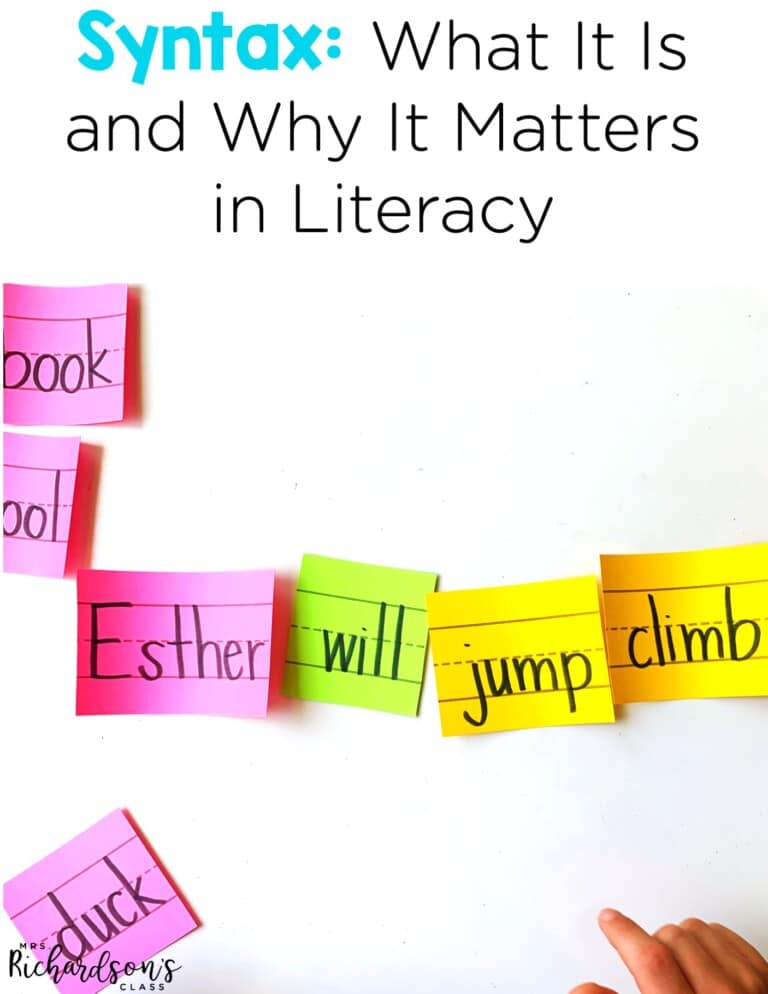


Things are changing with how we teach reading, but they are good changes! I’ve been digging into the Science of Reading and how it fits with Guided Reading. One of the popular topics in the literacy world right now is using a decodable reader to help students with their phonics skills and to learn how to read. If you have found yourself wondering wanting to learn more about decodable readers and how to use them, you’re in the right spot! Let’s dive in and chat about them!
Decodable readers are texts that focus on a specific phonics skill. The phonics skill is repeated throughout the text so students have ample practice with the skill. The phonics skill should have been previously taught by the teacher.
Decodable readers also include high-frequency words that they can decode based on the phonics skill. They tell a story and have meaning. A short /o/ decodable reader will have lots of short /o/ words for students to have repeated practice within the text. For example, if you teach short /a/, /e/, and /i/ before short /o/, students should also have the opportunity to review and practice those short vowel sounds as well in the short /o/ text.
Decodable readers reinforce the phonics skills you have taught to your students. A decodable reader lets you know if a student really understands the phonics skill you taught because they should be able to apply the skill. The carefully chosen words in a decodable reader allow students to practice decoding with their existing phonics knowledge.
The high-frequency words in quality texts have also been carefully chosen. We want to teach students these words and help orthographically map them for students so that the words move to their long-term memory.
Decodable readers fit so nicely into the guided reading framework. Instead of using leveled readers for guided reading, try using decodable readers for your groups. You will follow some of the same elements from guided reading, but also include some new ones.
You will first want to review a previously taught phonics skill that is the focus of the text. Next, you will focus on that same phonics skill as you complete an activity together. You might do some word sorts together or build words with manipulatives that focus on the phonics skill. Then, you will introduce students to the high-frequency words they will encounter in the text and help orthographically map them for the students. You might use elkonin boxes to do this.
Next, you will introduce the decodable reader and set the purpose for reading. You’ll want to review the phonics skill that is introduced in the book, and then let students read the book while you take a running record on a student. Afterward, you will want to have a comprehension conversation with your readers and have them practice writing a sentence that uses words with the phonics skill from the book.
Having planned out lessons for a decodable reader helps us teach explicitly and systematically. We don’t want to just hand students the book and then talk about it at the end. You can do powerful work through word work and high-frequency word activities. It’s also so important to plan out the decoding strategies you want to teach your students with each book intentionally.
Need help finding decodable readers for guided reading? We are SO excited to have some for you! Each set has decodable books, detailed lesson plans, phonics practice materials, teaching posters, and more. You can get each set individually or grab the bundle to save.
Grab your set and get started today. You’ll have everything you need to help students master important phonics skills and boost your readers!

Want to use the latest research to boost your readers during small groups? This FREE guide is packed with engaging ideas to help them grow!

I’m a K-1 teacher who is passionate about making lessons your students love and that are easy to implement for teachers. Helping teachers like you navigate their way through their literacy block brings me great joy. I am a lifelong learner who loves staying on top of current literacy learning and practices. Here, you’ll find the tools you need to move your K-2 students forward!


| Cookie | Duration | Description |
|---|---|---|
| cookielawinfo-checkbox-analytics | 11 months | This cookie is set by GDPR Cookie Consent plugin. The cookie is used to store the user consent for the cookies in the category "Analytics". |
| cookielawinfo-checkbox-functional | 11 months | The cookie is set by GDPR cookie consent to record the user consent for the cookies in the category "Functional". |
| cookielawinfo-checkbox-necessary | 11 months | This cookie is set by GDPR Cookie Consent plugin. The cookies is used to store the user consent for the cookies in the category "Necessary". |
| cookielawinfo-checkbox-others | 11 months | This cookie is set by GDPR Cookie Consent plugin. The cookie is used to store the user consent for the cookies in the category "Other. |
| cookielawinfo-checkbox-performance | 11 months | This cookie is set by GDPR Cookie Consent plugin. The cookie is used to store the user consent for the cookies in the category "Performance". |
| viewed_cookie_policy | 11 months | The cookie is set by the GDPR Cookie Consent plugin and is used to store whether or not user has consented to the use of cookies. It does not store any personal data. |



One Response
Thank-You for your clear explanation about how and why we use decodable readers. We can teach with intention by finding good quality decodables that support our phonics instruction. I need to evaluate the decodable resources I have been using, and reconsider the use of leveled readers. Thanks for your inspiration and guidance helping us shift to the Science of Reading for our lessons and reading instruction.